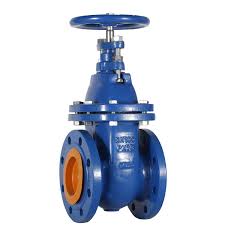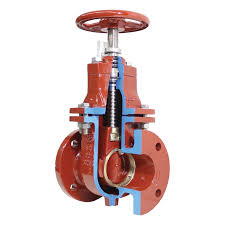Solid Wedge Gate Valve A217 C5 PN64 DN200 DIN Standard

The Application of Solid Wedge Gate Valve
The Solid Wedge Gate Valve is a widely used valve design in various industrial applications, offering a reliable and robust flow control solution. Unlike the Flexible Wedge Gate Valve, the Solid Wedge Disc Gate Valve features a one-piece, solid wedge disc that provides superior sealing performance and longer service life. The Solid Wedge Gate Valve is particularly well-suited for applications where tight shutoff and high-pressure capabilities are required, such as in the oil and gas industry. As a leading manufacturer, Cameron offers a wide range of Solid Wedge Gate Valve options, ensuring customers can find the perfect fit for their specific needs, whether it’s for handling aggressive fluids or withstanding extreme operating conditions.
What Are The Types Of Solid Wedge Gate Valve?
- Parallel Solid Wedge Gate Valve:
- The gate moves parallel to the pipe centerline when opening and closing.
- Provides a straight, unobstructed flow path when fully open.
- Commonly used in pipelines and process applications.
- Inclined Solid Wedge Gate Valve:
- The gate moves at an angle to the pipe centerline when opening and closing.
- Offers a more compact design compared to parallel gate valves.
- Often used in tight spaces or where access is limited.
- Expanding Solid Wedge Gate Valve:
- The wedge-shaped gate expands to create a tight seal against the valve seats.
- Provides excellent shutoff and minimal leakage when closed.
- Suitable for high-pressure and critical shut-off applications.
- Solid Wedge Slab Gate Valve:
- Features a solid, one-piece gate design without a flexible wedge.
- Provides reliable sealing and long service life.
- Used in applications with high pressure, temperature, or corrosive conditions.
What Is Solid Wedge Gate Valve?
A Solid Wedge Gate Valve is a type of industrial valve that utilizes a solid, one-piece wedge-shaped disc to control the flow of fluids or gases. Unlike Flexible Wedge Gate Valves, which have a two-piece disc design, the Solid Wedge Gate Valve features a monolithic gate that provides superior sealing integrity and extended service life. This robust construction makes the Solid Wedge Gate Valve well-suited for applications that require reliable shutoff, high-pressure capability, and the ability to handle challenging media. The solid wedge design also minimizes the risk of the gate becoming stuck or distorted, ensuring smooth and dependable operation even in demanding process environments.
How to Select the Right Solid Wedge Gate Valve?
When selecting the appropriate Solid Wedge Gate Valve for an application, several key factors must be considered:
Process Conditions: Evaluate the pressure, temperature, and flow rate requirements to ensure the valve’s specifications match the system demands. Valve Size should be properly sized to optimize flow and minimize pressure drop.
Material Compatibility: Choose valve materials, such as body and trim, that are compatible with the media being handled to prevent corrosion or erosion.
Valve Features: Determine the necessary features, such as Seat Tightness, Fire-Safe Design, or Anti-Blowout Stem, based on the specific application requirements.
Installation Considerations: Assess factors like Valve Orientation, Accessibility, and Maintenance Requirements to select a Solid Wedge Gate Valve that integrates seamlessly into the piping system.
By carefully evaluating these key selection criteria, engineers can ensure the Solid Wedge Gate Valve meets the performance, safety, and reliability needs of the application.
Features of Solid Wedge Gate Valve
Sealing Integrity:
The solid, one-piece wedge design of the Solid Wedge Gate Valve creates a tight, metal-to-metal seal against the valve seats, providing superior shutoff performance and minimizing the risk of leakage.
Pressure Capability:
The robust construction of the Solid Wedge Gate Valve allows it to withstand high-pressure applications, making it suitable for use in demanding industrial environments.
Flow Optimization:
When fully open, the Solid Wedge Gate Valve offers a straight, unobstructed flow path, minimizing pressure drop and ensuring efficient fluid or gas transportation.
Durability and Reliability:
The simplified, single-piece wedge design of the Solid Wedge Gate Valve reduces the risk of mechanical failure, ensuring reliable operation and extended service life.
Design Flexibility:
Solid Wedge Gate Valves are available in a variety of configurations, including parallel, inclined, and expanding styles, to accommodate diverse application requirements.
Maintenance Considerations:
The straightforward design of the Solid Wedge Gate Valve makes it easier to inspect, service, and maintain, reducing the overall lifecycle cost of the valve.
Advantages and Disadvantages of Solid Wedge Gate Valve
Advantages of Solid Wedge Gate Valve:
Tight Shutoff:
The solid, one-piece wedge design provides an exceptional sealing capability, ensuring minimal leakage when the valve is closed.
High-Pressure Capability:
The robust construction of the Solid Wedge Gate Valve allows it to withstand high-pressure applications, making it suitable for demanding industrial environments.
Durability and Reliability:
The simplified, single-piece wedge design reduces the risk of mechanical failure, resulting in reliable long-term performance.
Easy Maintenance:
The straightforward design of the Solid Wedge Gate Valve simplifies inspection, service, and maintenance, reducing the overall lifecycle cost.
Versatility:
Solid Wedge Gate Valves are available in various configurations, including parallel, inclined, and expanding styles, to accommodate diverse application requirements.
Disadvantages of Solid Wedge Gate Valve:
Increased Pressure Drop:
The solid wedge design can result in a higher pressure drop compared to other gate valve types when the valve is in the fully open position.
Limited Flow Capacity:
The solid wedge design may restrict the maximum flow capacity of the valve compared to alternative designs, such as the Flexible Wedge Gate Valve.
Higher Cost:
The robust construction and specialized manufacturing process of Solid Wedge Gate Valves can lead to a higher acquisition cost compared to some other gate valve types.

The Specifications of Solid Wedge Gate Valve
| Specification | Value |
|---|---|
| Type | Solid Wedge Gate Valve |
| Ball Material | Carbon Steel |
| Attachment Type | Flanged |
| Thread Standard | ASME B16.5 |
| Thread Size | 2 inch |
| Body Material | ASTM A216 WCB Carbon Steel |
| Safe for Use With | Water, Steam, Oil, Gas, Chemicals |
| Handle Type | Handwheel |
| Handle Material | Carbon Steel |
| Maximum Working Pressure (psi) | 600 psi |
| Maximum Working Pressure (bar) | 41.4 bar |
| Operating Pressure | 400 psi (27.6 bar) |
The Installation Steps for Solid Wedge Gate Valve
Step 1: Valve Inspection
Carefully inspect the Solid Wedge Gate Valve to ensure there is no damage or defects. Check that all components, such as the gate, seats, and stem, are in good working condition.
Step 2: Flange Preparation
Clean the mating flanges on the pipeline, removing any dirt, rust, or debris. Ensure the flange faces are smooth and free of any irregularities.
Step 3: Valve Orientation
Determine the correct orientation of the Solid Wedge Gate Valve based on the pipeline configuration and the flow direction. The valve should be installed with the gate in a vertical position.
Step 4: Gasket Placement
Select the appropriate gasket material and size, and place it between the valve flanges and the pipeline flanges, ensuring proper alignment.
Step 5: Bolt Tightening
Insert the flange bolts and tighten them in a crisscross pattern, gradually increasing the torque to the recommended value of 60-80 ft-lbs for a 2-inch Solid Wedge Gate Valve.
Step 6: Valve Actuation
Operate the valve’s handwheel or actuator to ensure the gate moves smoothly through its full range of motion, from the fully open to the fully closed position.
Step 7: Leak Testing
Perform a leak test on the installed Solid Wedge Gate Valve to ensure there are no fluid or gas leaks at the flange connections or around the valve stem.
Step 8: Final Inspection
Visually inspect the installed Solid Wedge Gate Valve for any signs of damage or improper installation. Ensure all fasteners are properly tightened and the valve is functioning as expected.
The Operation Theory of Solid Wedge Gate Valve
Operation Theory of Solid Wedge Gate Valves:
Solid Wedge Gate Valves use a one-piece, solid wedge that is designed to create a tight, metal-to-metal seal against the valve seats when the valve is in the closed position. The wedge is raised and lowered using a stem that is connected to the valve’s handwheel or actuator. As the wedge is lowered, it creates a tight seal by pressing against the seats, blocking the flow of fluid or gas. When the wedge is raised, it opens the valve, allowing the media to flow through the unobstructed flow path.
Solid Wedge vs. Flexible Wedge Gate Valves:
The primary difference between Solid Wedge and Flexible Wedge Gate Valves lies in the design of the wedge:
Solid Wedge Gate Valves:
- Use a one-piece, solid wedge design that creates a tight, metal-to-metal seal against the valve seats
- Offer superior shutoff performance and minimize the risk of leakage
- Have a more robust construction, allowing them to withstand high-pressure applications
- May have a higher pressure drop when in the fully open position compared to Flexible Wedge Gate Valves
Flexible Wedge Gate Valves:
- Use a two-piece, flexible wedge design that can adapt to the valve seats
- Provide a tighter seal, even with slight seat or wedge distortion
- Offer lower pressure drop when in the fully open position
- May be more susceptible to wear and tear over time due to the flexible wedge design